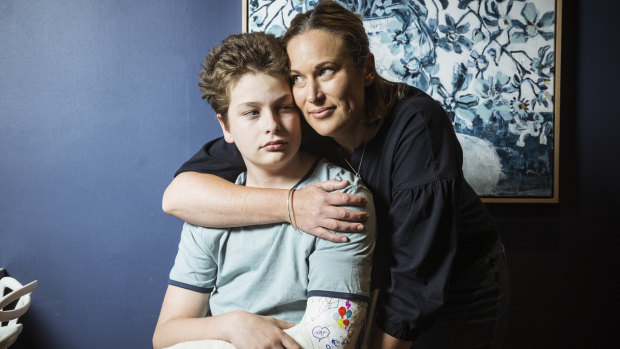By Robyn Grace
A specialised group of teachers who visit schools to work with vision- and hearing-impaired students could be fully absorbed into the teaching workforce, ending a decades-long service that provides disabled students with one-on-one support in state schools.
The 32 teachers were given a reprieve last week after the Education Department cut 85 other positions in an overhaul of its visiting teacher service. Under the change, “inclusion outreach coaches” will support schools working with students with additional needs, but teachers’ classroom sessions will be scaled back.

Emily Shepard says her 13-year-old son Louis won’t get specialised classroom support after cuts by the education department.Credit: Chris Hopkins
Education Minister Natalie Hutchins said on Thursday the vision and hearing roles “may be absorbed into teacher roles down the track” as the government’s $1.6 billion inclusion program was rolled out.
Parents say they have been blindsided by the proposal to cut the visiting teachers service, which will significantly reduce the number of specialised teachers who assist students with vision and hearing impairments, autism and other disabilities in the state’s public schools.
The Education Department announced last week that it would cut 325 full-time equivalent jobs. It said no school jobs would be affected, but staff employed by the visiting teacher service were classed as departmental employees. The proposal will reduce the number of visiting teacher jobs from 117 to 32.
Emily Shepard, whose son Louis has both vision and hearing impairment, said there had been no consultation by the department. She heard the news via email from a colleague.
“I was just completely deflated and shocked and just quite distressed,” she said. “How can this be happening? How come we haven’t heard about it? How come there’s no consultation?
“I can’t see any evidence that there is any thought process that has the best interest of the kids at the heart of it. This looks like a short-term budget fix with no thought about the repercussions long-term for some of the most vulnerable kids in the school system.”
Thirteen-year-old Louis has Usher syndrome, a rare degenerative condition that affects both sight and hearing. He has two specialist teachers who regularly visit his Mordialloc school.
Shepard said her only option if her son lost visiting teacher support was to use NDIS funding to hire private therapists to do site visits to the school - at four times the cost.
“It’s just moving the burden from one system to another,” she said.
“You remove those supports and the whole thing comes crashing down. The schools don’t have the capacity or the expertise or the versatility to understand the unique needs of children with either deafness or vision loss or a combination of both.”
Shepard, who heads an Usher syndrome support group, said she had called the department for answers, but was given no reassurance that children affected by the changes would be looked after.
“To take funding away from such a vulnerable group of children who are already struggling in a number of different categories, it’s just heartbreaking and it just screams inequality to me,” she said.
National Association of the Australian Teachers of the Deaf chairperson Kaye Scott said the cuts would inevitably affect frontline services. In one of the visiting teacher service’s four regions, nearly 1000 students at more than 300 schools received regular support from a visiting teacher, she said.
Scott said it would be “impossible” to maintain the current level of support with 32 staff statewide.
She said she had worked for the visiting teacher program as recently as 2021, when 12 staff in one region provided services to about 600 hearing-impaired students.
The department’s new figure equated to eight visiting teachers across each of the program’s four regions, servicing both vision and hearing-impaired students.
“It’s because of the supports they receive in primary school and secondary school that they’re able to keep in the ballpark with their peers and if they miss that support, we know that they fall behind and the gap gets bigger,” she said.
Scott said Victoria already offered significantly less classroom support than other states.
“And that’s before the cuts,” she said.
The department spokesperson said the government had invested $1.6 billion in disability inclusion since the visiting teacher service was implemented in the 1970s.
This included 82 “inclusion outreach coaches” to be deployed by next year to ensure continued support to schools working with students with additional needs. The current visiting teachers service would be scaled back and all other staff would be offered school-based positions, the spokesperson said.
The Morning Edition newsletter is our guide to the day’s most important and interesting stories, analysis and insights. Sign up here.